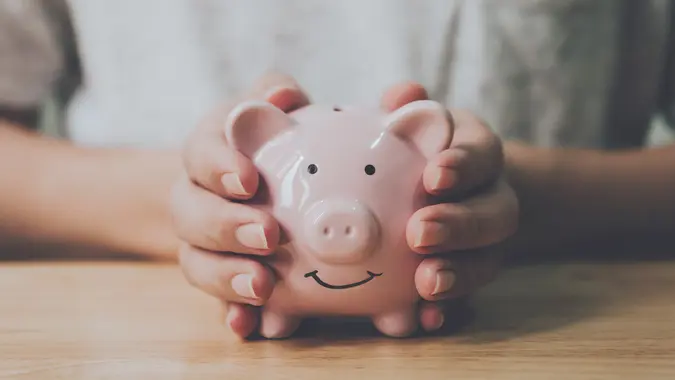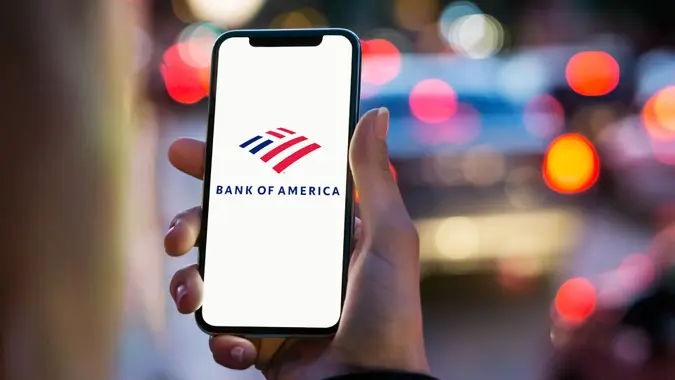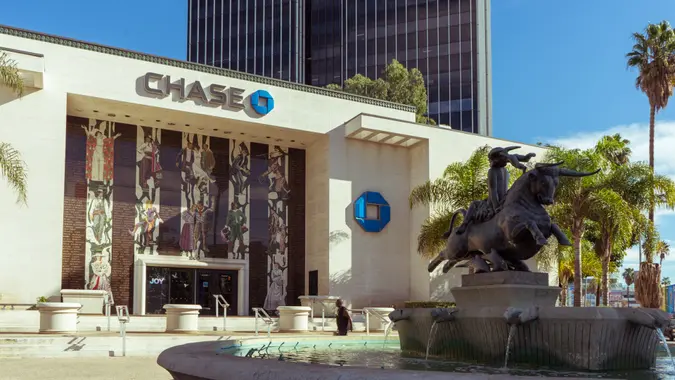How High Will Bank Savings Rates Go in 2025? Key APY Predictions

Commitment to Our Readers
GOBankingRates' editorial team is committed to bringing you unbiased reviews and information. We use data-driven methodologies to evaluate financial products and services - our reviews and ratings are not influenced by advertisers. You can read more about our editorial guidelines and our products and services review methodology.

20 Years
Helping You Live Richer

Reviewed
by Experts

Trusted by
Millions of Readers
People looking to maximize the returns on their savings may be eager to know APY predictions for 2025. How much do high-yield savings account rates change based on economic conditions? And given recent Fed rate cuts, will high-yield savings rates go down in the near future, and exactly when will savings rates drop?
Interest rates have been rising over the past few years, making high-yield savings accounts and CDs smart places to earn risk-free returns on your money. However, recent trends could mean that rates may go down in the coming months. To help you get a handle on what to expect, here’s a savings rates forecast for 2025, with key APY predictions and trends as well as some advice on making the most of your savings this year.
The Current State of Savings Account Rates
The average national rate for a traditional savings account is 0.42% as of Jan. 21, 2025, according to the FDIC. One smart alternative is to put your money in a high-yield savings account, where deposits can earn around ten times more in interest. These accounts are typically found at online banks without the high overhead of brick-and-order buildings. Currently, high-yield savings accounts at the best banks offer annual percentage yields of around 4.00%.
Rates on both standard and high-yield accounts were much lower three years ago–but then the pandemic and runaway inflation caused prices on everything from groceries to gas to rise at an alarming rate. This prompted the Federal Open Market Committee to combat inflation by raising the target range for federal funds 11 times over the past three years.
Factors Influencing Savings Rates
The federal funds rate is the rate banks charge to lend each other money overnight, and banks use it as a benchmark to set other rates, including the yields they pay on savings accounts and certificates of deposit. While the rates don’t move in lockstep, they do tend to move in the same direction, with bank yields increasing when the federal funds rate goes up and decreasing when the federal funds rate goes down.
Until March 16, 2022, the federal funds rate was just 0.00% to 0.25%. But once inflation reared its head, the Fed began increasing the federal funds rate in March, since rate increases discourage borrowing and spending, which slows down the economy and helps to rein in consumer prices. A total of 11 rate hikes have occurred since March 2022.
Federal Funds Rate Hikes Since 2022
| Date | Rate Increase |
|---|---|
| July 2023 | 5.25% – 5.50% |
| May 2023 | 5.00% – 5.25% |
| March 2023 | 4.75% – 5.00% |
| February 2023 | 4.50% – 4.75% |
| December 2022 | 4.25% – 4.50% |
| November 2022 | 3.75% – 4.00% |
| September 2022 | 3.00% – 3.25% |
| July 2022 | 2.25% – 2.50% |
| June 2022 | 1.50% – 1.75% |
| May 2022 | 0.75% – 1.00% |
| March 2022 | 0.25% – 0.50% |
The last time interest rates were increased this much was back in 1980, when rates touched 20% — a historic all-time high.
Over time, the Fed’s fight against inflation has made significant progress: The inflation rate was 8.5% in March 2022. The rate had dropped to 2.9% in December 2024, much improved but still 0.9% above the Fed’s 2% target.
By fall 2024, with inflation subsiding somewhat, the Fed began slashing rates at their meetings on September 18, November 7 and December 19. Their last cut lowered the target range for the federal funds rate by 25 basis points to 4.25% to 4.50%, bringing the rate to its lowest level since December 2022.
How Inflation and Economic Trends Affect APY
In addition to tamping down on inflation, recent Fed rate cuts have caused rates in high-yield savings accounts and CDs to level off in 2024 and begin to dip near the end of the year. This has fueled questions over where APY rates may head next.
The Dec. 18 meeting was the FOMC’s last meeting of 2024. Since the federal funds rate will remain unchanged for now, savings rates are unlikely to change significantly before the FOMC’s next meeting, which is scheduled to begin on January 28.
Predictions for Savings Rates in 2025
The Fed is expected to ease off on rate cuts in 2025 in their ongoing battle against inflation. Although FOMC members predict that inflation will eventually fall to the central bank’s goal of a 2% annual rate, the descent would likely be gradual and take some time.
The minutes from the Dec. 18 FOMC meeting indicated that the pace of rate cuts would slow considerably in 2025, with the median respondent expecting 75 basis points of cuts for the entire year.
“Members concurred that inflation had made progress toward the Committee’s 2 percent objective but remained somewhat elevated,” the minutes noted. “Almost all members agreed that the risks to achieving the Committee’s employment and inflation goals were roughly in balance. Members viewed the economic outlook as uncertain and agreed that they were attentive to the risks to both sides of the Committee’s dual mandate.”
Federal Reserve Board members and Federal Reserve Bank presidents made economic and federal funds rate projections in December 2024. The median projection for the year-end 2025 funds rate was 3.9%. That’s higher than the previous expectation of 3.4% in September, reflecting a total of just two quarter-point rate cuts in the year ahead.
As a result of the Fed’s slower pace of rate cuts in 2025, bank savings account rates are also unlikely to go down much. However, they’re also unlikely to rise in the immediate future.
What Falling or Stagnant Rates Mean for Savers
Rates implemented in 2024 made high-yield savings accounts and CDs good places to earn risk-free returns, providing a great opportunity to grow savings faster. While you won’t find 7% rates in 2025, a number of well-known banks are offering around 4%.
This savings rate could change later this year based on the Fed’s next moves. If the Fed raises their target rate, savings rates could climb. If the Fed lowers their target rate, savings rates could dip further. The Fed could also hold rates study, which would likely cause savings rates to not change much at all.
But even though interest rates have gone down, certain banks are likely to still offer high rates. This is because regardless of the Fed’s actions, banks may need to entice new and existing customers, particularly with increased competition from online and traditional banks alike. Since rates and terms will vary, it’s important to shop around and compare your options to get the best deal.
Strategies to Maximize Returns Regardless of Rate Changes
If you’ve got your savings in a traditional checking or savings account but are looking for a higher return on your savings, you may want to switch to, or add, a high-yield savings account to your portfolio. Since these online banks offer around ten times the returns compared to standard brick-and-mortar banks, it’s a simple way to earn more for every dollar you have socked away.
One potential downside to consider with high-yield savings accounts is that the APY may fluctuate based on market conditions. If you prefer to lock in high returns during these uncertain times, you may want to consider fixed-rate options like a CD, which guarantees a certain rate for the period of time they hold your money. Terms on CDs vary typically from as little as three months to five years, with the rate rising the longer you lock in your money.
Another option is to consider diversifying your savings with other types of investments, including stocks, mutual funds and ETFs. While many of these investments can carry more risk than a savings account or CD, they may also result in higher returns, and can be a way to grow your money faster and balance out a more conservative savings portfolio.
Best Accounts With High Interest Rates
It’s important to put your money in the right place, especially when savings rates are high. Here are five of the best accounts with high-yield rates for earning more from your savings.
| Bank | Savings Account and APY | 1-Year CD Rate |
|---|---|---|
| Ally | Online Savings Account — | |
| Capital One | 360 Performance Savings — * | * |
| Discover | Online Savings Account — | |
| Synchrony Bank | High Yield Savings — | |
| SoFi® | Checking and Savings Account — up to * | N/A |
What Makes a Good Savings Account in 2025?
Consumers should look for a bank that has high savings rates. But it’s not just about this one number. For anyone considering switching banks for better savings account, consider:
- The amount of cash to which the savings rate applies
- Monthly fees after opening an account
- Any sign-up bonus offers
- Minimum balance requirements
FAQs About Savings Rates and Their Future
Here are answers to some other common questions people have about savings rates right now:- Why are savings rates tied to the Federal Reserve's decisions?
- The federal funds rate refers to the interest rate banks charge one another for overnight loans. This rate serves as a reference point for determining other rates, such as the returns offered on savings accounts and certificates of deposit. Although these rates don't change at the exact same pace, they typically follow the same trend, rising when the federal funds rate increases and falling when it decreases.
- Are high-yield savings accounts safe during rate changes?
- Yes, high-yield savings accounts are generally safe during rate changes. These accounts are typically insured by the FDIC or NCUA, which means your deposited funds are protected up to the insured limit. While rate changes can cause interest rates on high-yield savings accounts to fluctuate, your principal remains safe.
- When is the best time to switch savings accounts?
- When the Federal Reserve meets and decides to raise or lower interest rates, this may cause banks to adjust the rates they offer their customers on savings accounts. So it's worth keeping an eye on when the Fed meets next and then checking how your bank--and competing banks--react. If your current account isn't keeping up with competitive rates, it may be time to switch to one with better returns.
Final Take
Savings account rates are influenced by a variety of factors, including the Federal Reserve’s interest rate and the state of the overall economy. Given how much rates fluctuate, it’s important to stay informed and proactive. When the Federal Reserve adjusts its rates, banks often follow suit, impacting the returns you earn on your savings. Keeping an eye on these changes ensures you’re not leaving potential earnings on the table.
With high-interest savings accounts offering yields of up to 4.00% or more at some banks, it’s a great way for people to earn a return on their cash. Consumers may also want to take some time to review their current savings strategy for 2025. Is your account offering a competitive interest rate? Are there better options that fit with your financial goals? Exploring and comparing high-yield savings accounts or promotional offers from various banks could help you grow your savings faster, and regularly reevaluating your options helps ensure that your money is working as hard as possible for you.
More on Savings Accounts
- What a Fed Rate Increase Means for Savings Accounts
- How Much Should I Have in Savings?
- What Is a High-Yield Savings Account?
More on Interest Rates
Daria Uhlig, David Granahan and Cynthia Measom contributed to the reporting for this article.
Rates are subject to change; unless otherwise noted, rates are updated periodically. All other information on accounts is accurate as of Jan. 21, 2025.
Capital One interest rates accurate as of 12/4/2025. See website for all current rates.
Annual percentage yield (APY) is variable and subject to change at any time. Rates are current as of 11/12/25. There is no minimum balance requirement. Fees may reduce earnings. Additional rates and information can be found at https://www.sofi.com/legal/banking-rate-sheet
*Earn up to 4.30% Annual Percentage Yield (APY) on SoFi Savings with a 0.70% APY Boost (added to the 3.60% APY as of 11/12/25) for up to 6 months. Open a new SoFi Checking & Savings account and enroll in SoFi Plus by 1/31/26. Rates variable, subject to change. Terms apply at sofi.com/banking#2. SoFi Bank, N.A. Member FDIC.
Our in-house research team and on-site financial experts work together to create content that’s accurate, impartial, and up to date. We fact-check every single statistic, quote and fact using trusted primary resources to make sure the information we provide is correct. You can learn more about GOBankingRates’ processes and standards in our editorial policy.
- U.S. News. 2025. "Savings Interest Rate Forecast."
- FDIC. 2025. "National Rates and Rate Caps."
- Trading Economics. "United States Inflation Rate."
- CNBC. 2024. "Fed cuts by a quarter point, indicates fewer reductions ahead."
- Federal Reserve. "Meeting calendars, statements, and minutes (2020-2026)."
- Transamerica. 2024. "Adjusting Rate Forecast as Fed Shifts Narrative."
 Written by
Written by  Edited by
Edited by 

























